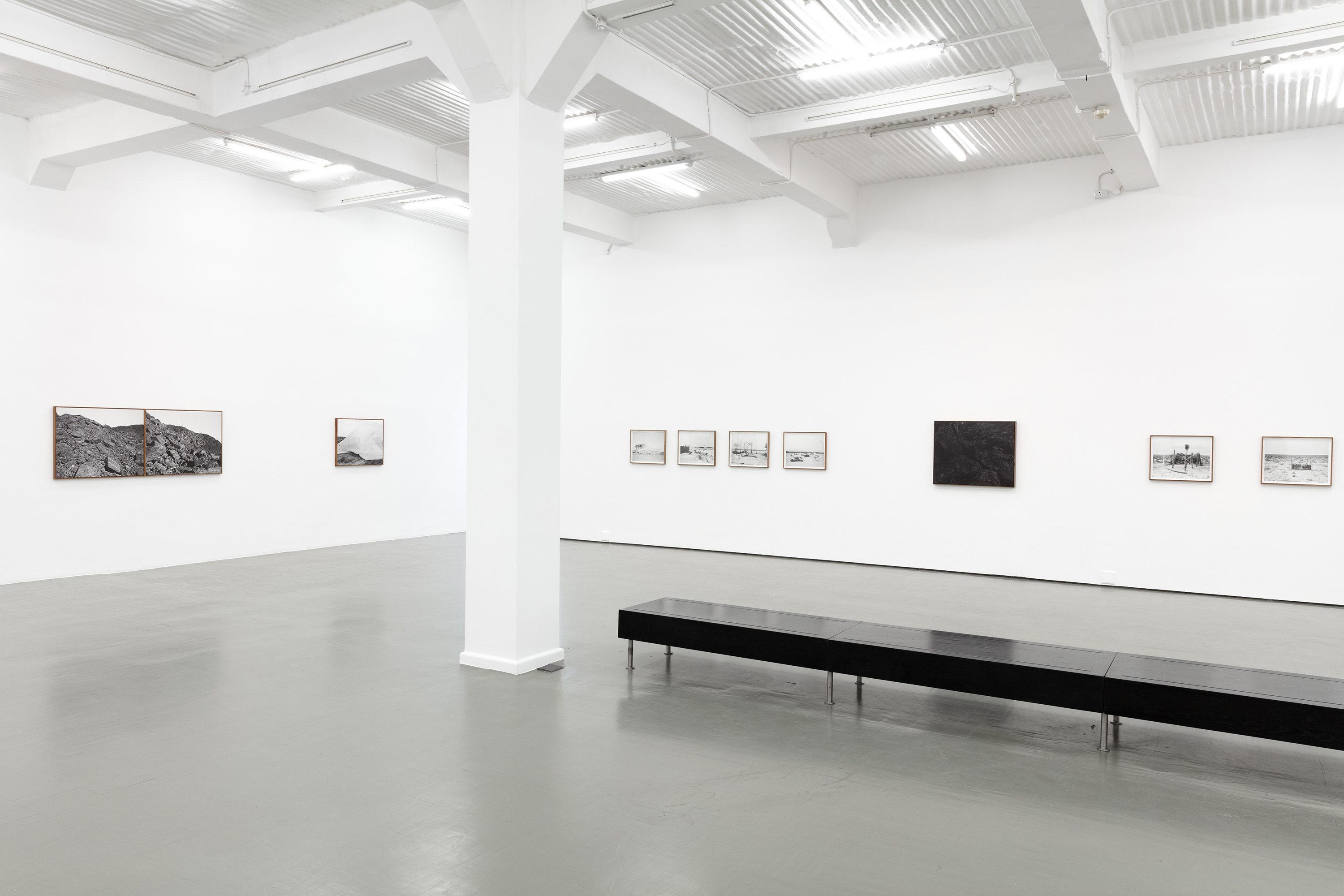Cape Town
7 October - 25 November 2023Jo Ractliffe
Landscaping

Landscaping, 2023, installation view
Landscape is a way of seeing that has its own history, but a history that can be understood only as part of a wider history of economy and society.
- Denis Cosgrove, Social Formation and Symbolic Landscape, 1998
STEVENSON is pleased to present Landscaping, a solo exhibition of photographic works by Jo Ractliffe.
The exhibition comprises black and white images taken during a series of long-distance drives across the west coast of Southern Africa. Ractliffe, known for her ability to engage place as a telling artefact, turns her attention to both the content of the landscape as well as the context of the genre. She moves close to the subjects and features of her images, registering the details of obliterated geographies in abstracted terms, spotlighting the tension between visible forms of violence and the unspoken toll of collateral damage. She writes:
Unlike previous work, where my photographic seeing was focussed on the traces of violence and its aftermath, I began this project without any preconditions or preconceptions of what might draw my attention. My modus operandi, as it were, was a kind of slow meandering; following dirt tracks, taking wrong turns, paying attention to everything. Over the past year, my journeys have taken me back to familiar places and to others I didn’t even know existed.
This exhibition has forced me to confront ‘landscape’. I have always struggled with the term, the way it speaks to a view rather than actual concrete space – and how it seems to conflate this view, or representation, with the actual place itself. But ‘landscape’ is not geography or space out there; it’s already a contrivance. When talking about my work, I still find myself disclaiming the term in an attempt to wrestle my photographs away from the stereotypical conventions of landscape – what William Kentridge calls ‘the plague of the picturesque’. Because to speak of landscape in terms of beauty, or even unsightliness for that matter, is to observe rather than participate, to reduce space and place to a concept rather than lived experience.
The works in Landscaping, for which Ractliffe has received the 2022 Lewis Baltz Research Fund, act as a visual chronicle of the movements of power, operating at both the register of statement and subtext. The artist navigated spaces such as Velddrif, a river estuary that houses birdlife and salt factories; Hondeklipbaai, home to diamond-diving and kelp-harvesting; and Alexander Bay, established to service the mining industry. Drawing connections between unspoken histories and a tenuous present, she expands:
In the first draft of this statement, I described the Atlantic coastline as arid and windswept. Reading back I realised that my portrayal unwittingly reiterated those of colonial settler narratives that propagated an ‘empty land’ - with the frontiersman the intrepid explorer bent on conquest and discovery. Many towns in Namaqualand came about with the ‘discovery’ of copper in Okiep in 1685 (after encounters with local Namaqua, who wore copper bracelets and may well have been working copper in the region for several hundred years). Later, in 1926, the discovery of alluvial diamonds along the coast from the Orange River mouth southwards brought a new rush of fortune-hunters, and mining took hold. Frontier mythology resurfaces in the contemporary romanticism of the West Coast and Namaqualand; tourist brochures relate stories of whalers, sailors and shipwrecks along the coast, although ‘windswept’ and ‘arid’ have been largely replaced by descriptions of ‘unspoiled scenery’, ‘quaint historic towns’ and ‘warm hospitality’.
Absent from both narratives is the lived experience of local communities, those previously dispossessed of their land and who remain marginalised and unresourced. The aftermath of over a century of industrial extraction of diamonds, copper and heavy mineral sands along this coastal landscape has left a blighted countryside; once-flourishing mining towns lack proper services and the unemployment rate is one of the highest in the country. In Okiep, for example, an unpublished document of the Okiep Copper Company lists 41 different mining sites that remain unrehabilitated, simply because mining practices at the time preceded the drafting and enforcement of any environmental protection legislation. Today, local residents still live amongst the mines, tailings heaps, smelter sites and treatment plants – and contaminated soil and water. On Women’s Day in August 2023, members of WoMin African Alliance were arrested in Concordia after protesting what they say was illegal mining by a large mining company, on land that had been expropriated and returned to the community earlier this year.
Such broken terrain brings to mind Rob Nixon’s concept of ‘slow violence’, which he defines as ‘a violence that occurs gradually and out of sight, a violence of delayed destruction that is dispersed across time and space, an attritional violence that is typically not viewed as violence at all’.
Ractliffe works with hand-held, analogue cameras, and her route is set by maps and information shared during exchanges with townspeople and amateur historians. In Landscaping, the artist delves further into her own embeddedness in the terrain, offering new ways to think through the action of witnessing in the aftermath of extraction. She concludes:
In his book Landscape and Power (2002), WJT Mitchell argues that ‘landscape’ should be considered a verb rather than a noun, something that shapes and is shaped by social and political practices. In using the word Landscaping as the title of this exhibition, I have tried to activate the idea of landscape, to make of it a ‘doing thing’ that resists easy apprehension and asks us to consider where we look from and what is it that we think we are looking at.
This work has been produced with the support of the Lewis Baltz Research Fund 2022.
The exhibition opens on Saturday 7 October, 10am to 1pm. Ractliffe will give a walkabout at 11am on the day of the opening.

